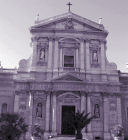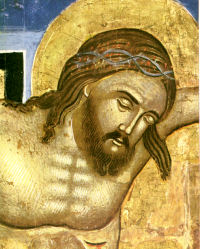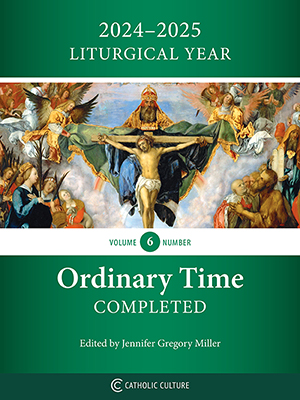Lent: March 21st
Saturday of the Third Week of Lent
Other Commemorations: St. Nicholas of Flüe (RM)
» Enjoy our Liturgical Seasons series of e-books!
Sin is the great barrier between God and man. Sin, caused the beginning of hell and made devils of the fallen angels. Sin drove Adam and Eve out of their paradise and took away their marvelous gifts of grace and of freedom from sickness and death. But only in the sufferings and death of the God-man do we see what God really thinks of sin. Before sin there existed no sickness, no death, no hatred, no discord, no ugliness. Every suffering and disorder in the world is a reflection of sin. Every Mass, continuing the atoning Sacrifice of Calvary, is God's mercy to sinners throughout the world. Every sacrament is God's means of restoring all things in Christ. — Daily Missal of the Mystical Body
According to the 1962 Missal of St. John XXIII the Extraordinary Form of the Roman Rite, today is the feast of St. Benedict, "Father of Western Monasticism," twin brother of St. Scholastica. His feast in the Ordinary Form of the Roman Rite is celebrated on July 11.
Meditation - On the Compassion of Some Women of Jerusalem
A goodly number of the women of Jerusalem (not disciples of Jesus) met this saddest of funeral processions. No doubt their weeping and sobbing and loud wailing, however sincere, was not in real accord with the sorrow that was straining Jesus' heart to the breaking point-His sorrow, namely, over their refusal to accept the truth of His Messiahship and of His supreme royalty as the promised Christ and Savior. Still, the heart of Jesus was deeply affected by the sympathy of these women. Contrasted with all else that was poured into His ears, it was very acceptable and was gratefully received.
But what lastingly gives this incident its chief significance is the fact that, even here in His greatest misery, Jesus is thinking predominantly of the doom of the Holy City and its temple, now practically sealed. Evidently His heart is aching at the vision of the horrors that will soon overtake it and the whole Jewish race, for its criminal blindness to His divine credentials and its obstinate refusal to profit by His teaching and His Precious Blood. For the days are near, when the barren among the Jewish women will be called blessed; when death, sudden and terrible though it be, will seem preferable to life. Try, therefore, to look deep into Jesus' Sacred Heart in its very keen sympathy for these women, and especially for their children. For of the children here present in the procession, or carried in the arms of their mothers, many no doubt were to be witnesses and victims of the abomination of desolation coming upon Jerusalem not forty years hence (Luke 19:41-44)
Excerpted from Our Way to the Father by Leo M. Krenz, S.J.

Saturday in the Third Week of Lent, Station with Santa Susanna (St. Susan):
The Station is in the church of St. Susanna, virgin and martyr of Rome. The first Christian place of worship was built here in the 4th century. It was probably the titulus of Pope Caius (283-296). Caius was St. Susanna's uncle, and tradition claims that the church stands on the site of her martyrdom. The church is now the national parish of the United States since 1922.
St. Nicholas of Flüe
Nicholas was born into a family of prosperous farmers, who owned the Kluster Alp and the estate of Flüeli on the Sachsterberg (near Lucerne), from which their surname derives. At various times Saint Nicholas was a soldier, peasant, patriot, and judge in Switzerland. His father held a civil post; his mother was very devout and raised her sons to belong to the brotherhood of the Friends of God (Gottesfreunde). The society sought to live a strict life, to meditate on the passion of the Lord, and to seek a close relationship with God. They lived with their families in small communities or as hermits. Thus, Nicholas was pious from childhood. He was also illiterate.
In his youth Nicholas fought in defense of Swiss Confederation liberties, especially against the Hapsburgs. After the siege of Zurich in 1439, he was commissioned in the army. He defended women and children and the Church, fighting “with a sword in one hand, and a rosary in the other!”
He loved solitude and prayer, but, by 1447, he married pious and comely Dorothea Wysling, daughter of one of the chief families of Sachseln. In the 30 years of their marriage, he had 10 children: John, Rudolph, Walter, Henry, Nicholas, Dorothea, Marguerite, Katherine, Veronica, and another girl who died in infancy. John was elected Landmann of Unterwald. Nicholas (the youngest) studied at the University of Basle and became a priest; another became a governor of the province. Dorothea’s piety led her to be called “the consolation of the Church.”
Nicholas would rise at dawn to tend the flocks, eat at 9:00 a.m. with his family and servants at the same table, and again at the end of the day they would gather for Vesperbrod and end the evening with family prayers. While working in the fields, he was often rapt in ecstatic prayer, experiencing visions and revelations. He continued the devout practices of his youth, fasted frequently, and often spent the night in prayer.
In 1460, Thurgau was invaded by Austria and Nicholas commanded 100 men. During this campaign at Katharinental the Swiss troops were faced with a situation that anticipated in miniature that at Monte Cassino in 1944: When the Swiss succeeded in capturing the village of Diesenhofer, many Austrian soldiers sought refuge in the church of the Dominican Convent of Saint Catherine. The Swiss command was going to burn the church, but Nicholas prayed for divine guidance before the crucifix in the cloister, then he asked the command to revoke its order stressing the moral gravity of the act. The order was canceled. Nicholas was awarded a gold medal when peace was declared, in thanks for his services.
Fellow-citizens wanted him to accept the office of Landmann (governor), but he twice refused. He was appointed magistrate, served as judge for the canton, and was sent as a deputy for Obwalden to councils. When, in 1465, a powerful family appealed his fair decision and was rendered an unjust one against a humble peasant, he resigned. “Later he testified that he could see and feel flames of fire, of a disgusting odor, issuing from the mouths of the judges as they pronounced their unjust sentence; and he knew that they already had a foretaste of hell within themselves.” Though the elite turned against him and spoke calumnies of him, Nicholas was still sought out by his neighbors and people from the adjoining cantons to settle disputes.
In 1467 (age 50), fourteen months after the birth of the tenth child, Nicholas heard God’s command to live as a hermit and told his wife immediately. He resigned his offices and, with his devout wife’s permission, left his family to live for the next 20 years as a hermit in almost perpetual prayer. Dorothea was overcome by the news but put no obstacles in his way because she recognized the call. “She wept as she made the supreme sacrifice” of allowing her husband to leave. His relatives and neighbors, however, were full of indignation, which he disregarded. Nicholas and his wife drew up an agreement and told the family and servants that Dorothea was thenceforth head of the family.
He left barefoot and bareheaded, wearing a drab habit and carrying a rosary and a staff. Thus clad as a pilgrim, Nicholas became known as Brother Klaus. He appears to have been headed for Strasbourg, France, where the headquarters of the Gottesfreunde lay, looking for a hermitage in which to spend his final years. On his way, however, he wandered toward Basle, where he was put up by a peasant who was a Friend of God, who told him that the Swiss were unpopular in Alsace and that he might not find there the life that he sought.
That night during a violent thunderstorm, Nicholas looked at a little town beyond the frontier and saw that lightning made it appear to be in flames. He took this as a divine confirmation of the peasant’s advice and turned back. When Brother Klaus decided to follow the peasant’s suggestion, he felt a violent pain in his intestines and was surrounded by light. Thereafter, he “never felt the need of human food or drink, and have never used them.” Hunters brought back to his family the news that they had seen him living on his pastureland in a shelter of boughs. Family members went to beg him not to stay there and fall prey to exposure.
So, he finally moved to Ranft, where the people of Obwalden built him a cell and a small chapel. He lived many years in this lonely place above a narrow gorge within earshot of the mountain stream spending most of his time in prayer. He prayed and meditated from midnight to midday, attended Mass in Sachseln every Sunday, and paid an annual visit to Lucerne for the Musegger procession. He never ate or drank anything except the Blessed Sacrament.
Abbot Oswald Isner wrote:
“When Nicholas had abstained for 11 days from taking natural food, he sent for me and asked me secretly whether he should take some food or continue to fast. He had always desired to live without eating, the better to separate himself from the world. I touched the parts of his body where little flesh was left; all was dried up; his cheeks were hollow and his lips were very thin.“When I had seen and understood that it could come only from divine love, I advised brother Nicholas to continue to this test as long as he could stand it without the danger of death. That is what brother Nicholas did; from that moment until his death, that is for about twenty-one and a half years, he continued to take no food for the body.
“Since the holy brother was more familiar with me than with anyone else, I asked him many times how he managed to do it. One day in his cell he told me, in great secrecy, that when the priest celebrated communion he received the strength which alone permitted him to live without eating or drinking.”
When those seeking his counsel asked him about eating nothing, Nicholas would reply, “God knows.” Cantonal magistrates had his cell watched for a month to ensure themselves of the fact that no one brought him food. Nevertheless, Nicholas held that “holy obedience is the highest virtue.” When Bishop Thomas visited him and commanded him to eat bread and a little wine after 18 months of nothing, Nicholas hesitated to obey. When he did try to eat a tiny fragment of a morsel, he almost choked to death and the bishop finally believed.
Until he had a chaplain, he attended Sunday Mass and Holy Days at the parish church of Sachseln. Nicholas founded a chantry for a priest with donations and thus was enabled to assist at Mass daily. In 1470, Pope Paul II granted the first indulgence to the sanctuary at Ranft and it became a place of pilgrimage. Occasionally Klaus would make a pilgrimage to Engleburg or Einsiedeln.
He received the great (including Emperor Frederick III), the humble, and children. Many pilgrims came for counsel. He could speak with authority to married people and children. His wife and children also attended Mass in his chapel and listened to his spiritual counsel.
In 1481, the Swiss Confederation had gained its independence from Charles the Bold of Burgundy, the rulers of Europe sought its alliance, and it was on the verge of breaking apart over how to divide the spoils gained during the conquests. Internal disputes threatened its solidarity, but an agreement was reached and put forth in the Compromise of Stans. Still unresolved, however, was the issue of the inclusion of Fribourg and Soleure, and it caused such controversy that in 1481 civil war was feared. A parish priest of Stans recommended seeking a final opinion from the 64- year-old Nicholas. This was agreed to, and he went to Nicholas, whose counsel had been sought at various stages of the drafting of the edict, and it has even been said that it was drawn up in his cell. After the priest’s return to Stans, the council arrived at a unanimous decision within an hour and maintained the unity of the land.
Despite his lack of education and experience with the world, his mediation led to permanent national unity for Switzerland. He could not even write; he used a special seal as a signature. Letters of thanks to him from Berne and Soleure still survive.
Six years later, he became ill for the last time. He suffered greatly for eight days, received Holy Viaticum, then died peacefully in his cell with his wife and children by his bed. Nicholas was buried at Sachseln and the Flüe family still survives in Switzerland.
His wife and children were probably none the worse for his becoming a hermit. It may be that his prayers and spiritual counsel did more for his family than his remaining with them would have. We do not blame explorers and soldiers for leaving their families, why blame a saint?
His canonization was delayed because a fire destroyed the documents relating to it. Nevertheless, he is the patron saint of Switzerland.
Several accounts survive of visitors’ memories of Bruder Klaus: one described him as tall, brown, and wrinkled with then grizzled locks and a short beard, bright eyes, white teeth, and a shapely nose. This corresponds well with a Fribourg portrait of him done in 1492 (Attwater, Attwater2, Benedictines, Bentley, J. Delaney, S. Delany, Encyclopedia, Farmer, White).
Saint Nicholas is portrayed as a hermit being thrown into a thorn bush by the devil. At other times he may be shown praying in a mountainous landscape or entering a house while carrying a staff tipped with a cross. Nicholas is greatly venerated in Switzerland (Roeder).
—taken from Saints of the Day by Katherine Rabenstein (from Catholic Encyclopedia






